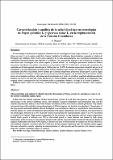Por favor, use este identificador para citar o enlazar a este item:
http://hdl.handle.net/10261/46821COMPARTIR / EXPORTAR:
 SHARE
BASE SHARE
BASE
|
|
| Visualizar otros formatos: MARC | Dublin Core | RDF | ORE | MODS | METS | DIDL | DATACITE | |

| Título: | Caracterización y análisis de la señal climática en cronologías de Fagus sylvatica L. y Quercus robur L. en la región central de la Cornisa Cantábrica |
Otros títulos: | Characterization and analysis of climatic signal in chronologies of Fagus sylvatica L. and Quercus robur L. in the central Cantabrian region, Spain | Autor: | Rozas Ortiz, Vicente Fernando CSIC ORCID | Palabras clave: | Tree rings Dendrochronology Spectral analysis Climatic response Regional climate NAO Anillos de crecimiento Dendrocronología Análisis espectral Respuesta climática Clima regional |
Fecha de publicación: | 2006 | Editor: | CSIC - Instituto Nacional de Investigación y Tecnología Agraria y Alimentaria (INIA) | Citación: | Investigación agraria. Sistemas y recursos forestales 15 (2): 182-196 (2006) | Resumen: | [EN] In this work, the climatic responses of three beech (Fagus sylvatica L.) and three oak (Quercus robur L.) tree-ring chronologies in the central Cantabrian region, were analyzed. Regional temperature and precipitation data, and the climatic teleconnection indices of the North Atlantic Oscillation (NAO), were used as climatic predictors. Very similar interannual ring-width variability among chronologies of different species and localities was displayed. Chronologies of the same species and similar altitudes showed the highest cross-correlations, which were significant at widest timescales. Periodic signals of a variety of frequencies that coincided with signals characteristic of NAO indices, were discovered in the chronologies. Between 52 to 64% of growth variance was explained by regional climate, while 13 to 27% was related to monthly NAO indices. High summer temperatures in the year prior to ring formation and low winter temperatures limited beech growth at altitudes over 700 m. Oak radial growth at lower altitudes was limited by high spring temperatures in the previous year and summer drought in the year the ring was formed. Growth of both species displayed negative relationship with winter NAO indices, in the previous year for beech and in the current year for oak. Moreover, oak exhibited a negative correlation with NAO indices in the late summer of previous year. The obtained results suggest that more exhaustive research, regarding the characterization of radial growth and the analysis of its climatic response along the complete Cantabrian region, is required. [ES] En este trabajo se analizaron las respuestas climáticas de tres cronologías de haya (Fagus sylvatica L.) y tres de roble (Quercus robur L.) en la región central de la Cornisa Cantábrica. Se utilizaron datos climáticos regionales y el índice de Oscilación del Atlántico Norte (NAO) como indicativo de la señal macroclimática. Las cronologías presentaron una variabilidad interanual similar entre especies y localidades. Las correlaciones mayores y más extensas en el tiempo se obtuvieron entre cronologías de la misma especie y similar altitud. Las cronologías presentaron señales de distinta frecuencia coincidentes con señales características de los índices NAO. El 52-64% de la variación del crecimiento fue explicada por el clima regional, mientras que la NAO explicó un 13-27%. La elevada temperatura estival del año previo al crecimiento y la baja temperatura invernal fueron factores limitantes para el haya por encima de 700 m de altitud. El crecimiento del roble a baja altitud estuvo limitado por la elevada temperatura primaveral del año previo y por la sequía estival del año de crecimiento. Ambas especies mostraron una relación negativa con los índices NAO invernales, del año previo al crecimiento en el haya y del mismo año de crecimiento en el roble. En el roble se manifestó además una relación negativa con la NAO de final del verano del año previo. Estos resultados sugieren la necesidad de investigaciones más extensas sobre la caracterización del crecimiento radial y su respuesta climática a lo largo de la Cornisa Cantábrica. |
Versión del editor: | http://www.inia.es/gcontrec/pub/SRF15(2)-05_(ROZAS)_1157613313531.pdf | URI: | http://hdl.handle.net/10261/46821 | ISSN: | 1131-7965 |
| Aparece en las colecciones: | (MBG) Artículos |
Ficheros en este ítem:
| Fichero | Descripción | Tamaño | Formato | |
|---|---|---|---|---|
| Rozas_Caracterización.pdf | 174,14 kB | Adobe PDF |  Visualizar/Abrir |
CORE Recommender
Page view(s)
322
checked on 23-abr-2024
Download(s)
102
checked on 23-abr-2024
Google ScholarTM
Check
NOTA: Los ítems de Digital.CSIC están protegidos por copyright, con todos los derechos reservados, a menos que se indique lo contrario.
